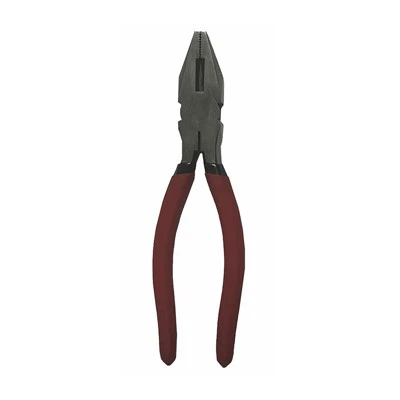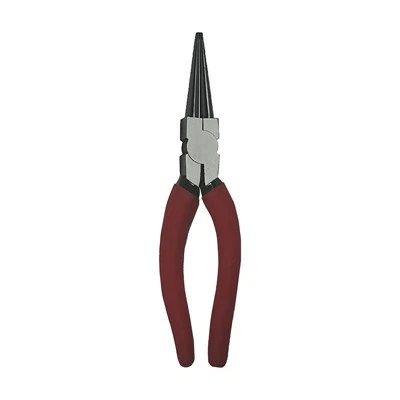Troubleshooting common problems with American Type Flat Nose Pliers is essential for both professionals and DIY enthusiasts. As a supplier of these versatile tools, I understand the importance of keeping them in top - notch condition. In this blog, I'll share some practical tips on how to diagnose and fix the most common issues that you might encounter with American Type Flat Nose Pliers.
Loose Joints
One of the most frequent problems with flat nose pliers is a loose joint. Over time, the constant opening and closing of the pliers can cause the joint to loosen, resulting in a lack of precision and reduced gripping power.
Diagnosis:
If you notice that the jaws of the pliers don't align properly or that there is excessive play when you open and close them, chances are the joint is loose. You can also try applying a small amount of pressure on the jaws while they are closed. If they move independently or if you feel a rattling sensation, it's a clear sign of a loose joint.
Solution:
The first step is to check if the joint screw is loose. Using a small screwdriver, carefully tighten the screw. Be careful not to overtighten it, as this can cause the jaws to bind or the screw to strip. If tightening the screw doesn't solve the problem, the joint may need to be lubricated. Apply a small amount of high - quality lubricant, such as silicone oil, to the joint. This will reduce friction and may help to stabilize the joint.
If the problem persists after tightening the screw and lubricating the joint, it's possible that the joint has worn out. In this case, you may need to replace the joint. Contact a professional tool repair service or refer to the manufacturer's instructions for guidance on replacing the joint.
Dull Jaws
Dull jaws are another common issue with flat nose pliers. Constant use on hard materials can cause the cutting edges of the jaws to become dull, making it difficult to grip or cut objects effectively.
Diagnosis:
If you find that the pliers are struggling to grip or cut materials that they used to handle easily, or if the edges of the jaws look worn or rounded, the jaws are likely dull.
Solution:
To sharpen the jaws, you can use a fine - grit file. First, secure the pliers in a vise to keep them steady. Then, gently file the cutting edges of the jaws at a 45 - degree angle. Make sure to file both sides of the jaws evenly to maintain symmetry. After filing, use a piece of fine sandpaper to smooth out any rough edges.
It's important to note that sharpening the jaws should be done carefully, as over - filing can damage the pliers. If you're not confident in your ability to sharpen the jaws, you can send the pliers to a professional tool sharpening service.
Bent Jaws
Bent jaws can occur when the pliers are used to apply excessive force or when they are dropped or mishandled. Bent jaws can affect the accuracy and functionality of the pliers.
Diagnosis:
Visually inspect the jaws to see if they are straight. If you notice that the jaws are misaligned or that they don't close evenly, they are likely bent. You can also try closing the pliers on a flat surface. If there are gaps between the jaws and the surface, this is a sign of a bend.
Solution:
If the bend is minor, you may be able to straighten the jaws using a pair of vice - grips. First, secure the pliers in a vise. Then, use the vice - grips to gently apply pressure to the bent area and slowly straighten the jaws. Be careful not to apply too much pressure, as this can cause the jaws to break.
For more severe bends, it's best to take the pliers to a professional tool repair service. They have the tools and expertise to straighten the jaws without causing further damage.
Rust and Corrosion
Rust and corrosion can occur when the pliers are exposed to moisture or if they are not properly maintained. Rust can weaken the pliers and make them difficult to use.
Diagnosis:
Look for signs of rust on the surface of the pliers, such as orange or brown spots. You may also notice that the pliers feel sticky or that the movement of the jaws is restricted.


Solution:
To remove rust, you can use a rust remover or a mixture of vinegar and water. Soak the affected parts of the pliers in the solution for a few hours, then use a wire brush to scrub away the rust. After removing the rust, dry the pliers thoroughly and apply a thin layer of oil to prevent future rusting.
If the rust has penetrated deeply into the metal, it may be necessary to sand or file the affected area to remove the rust completely. However, this should be done carefully to avoid damaging the pliers.
Tips for Preventing Problems
- Proper Storage: Store the pliers in a dry place, preferably in a toolbox or a tool rack. This will protect them from moisture and prevent rust and corrosion.
- Regular Maintenance: Clean the pliers after each use to remove any debris or dirt. Lubricate the joint regularly to ensure smooth operation.
- Correct Use: Use the pliers for their intended purpose only. Avoid using them to cut or grip materials that are too hard or too thick for the pliers, as this can cause damage.
In addition to American Type Flat Nose Pliers, we also offer a wide range of other high - quality pliers, such as Fence Pliers, Long Handled O - shaped Pliers, and Carpenters End Cutting Pliers.
If you're experiencing problems with your pliers or if you're looking to purchase new ones, don't hesitate to contact us for more information. We're here to help you find the right tools for your needs and to assist you in troubleshooting any issues that you may encounter. Our team of experts is always ready to offer advice and support to ensure that you get the most out of your tools.
References
- "Tool Maintenance Handbook", various authors
- Manufacturer's instructions for American Type Flat Nose Pliers





